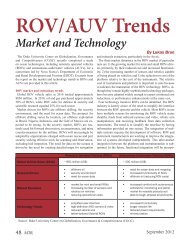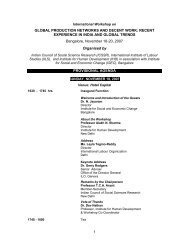Paper - Center on Globalization, Governance & Competitiveness
Paper - Center on Globalization, Governance & Competitiveness
Paper - Center on Globalization, Governance & Competitiveness
Create successful ePaper yourself
Turn your PDF publications into a flip-book with our unique Google optimized e-Paper software.
Draft<br />
Table 2<br />
Organizati<strong>on</strong>al structures of the associati<strong>on</strong>al ec<strong>on</strong>omy<br />
Hard Networks Associati<strong>on</strong>s Clusters<br />
Membership Closed Open, membership<br />
based<br />
N<strong>on</strong>e required<br />
Relati<strong>on</strong>ships Collaborative Cooperative Cooperative and<br />
competitive<br />
Basis for C<strong>on</strong>tractual Majority determinati<strong>on</strong> Social norms and<br />
agreements<br />
reciprocity<br />
Value added Allows firm to focus <strong>on</strong> Aggregates & organizes External ec<strong>on</strong>omies<br />
core competencies demand for services<br />
Major outcomes Increased profits and Shared resources, lower Access to suppliers,<br />
sales<br />
costs, benchmarking services, labor markets<br />
Basis of external Shared functi<strong>on</strong>s and Membership Locati<strong>on</strong>/proximity<br />
ec<strong>on</strong>omies resources<br />
Shared goals Business outcomes Collective visi<strong>on</strong> N<strong>on</strong>e required<br />
Delegati<strong>on</strong> after delegati<strong>on</strong> traveled to northern Italy to observe cooperati<strong>on</strong><br />
am<strong>on</strong>g firms. The networks were not easily observed, however. What we did<br />
see is the associati<strong>on</strong>al infrastructure, the specialized support system managed<br />
by ERVET, the regi<strong>on</strong>’s development agency, and government agencies<br />
programs that require or set aside funds for multi-firm initiatives. The Nati<strong>on</strong>al<br />
C<strong>on</strong>federati<strong>on</strong> of Artisans, with more than 500 employees providing 17,000 firms<br />
in Emilia Romagna, with accounting services, payroll, tax assistance, financing,<br />
and training was a mandatory stop <strong>on</strong> the tour; as were the many cluster hubs<br />
that offered services to small firms—e.g., CITER’s fashi<strong>on</strong> design for knitwear,<br />
CERMET’s testing labs and quality assurance for metalworking firms, RESFOR<br />
for matching suppliers with customers, etc. Networks formed, unformed, and<br />
reformed as necessity dictated. The social envir<strong>on</strong>ment and associati<strong>on</strong>al<br />
infrastructure created the opportunities.<br />
II. Mispercepti<strong>on</strong>s and Misapplicati<strong>on</strong>s of Clusters<br />
Like any popular and heavily marketed idea, clusters can be an effective strategy but, if<br />
misapplied or over-promoted as, for example, panaceas for ec<strong>on</strong>omic growth and<br />
sustainability, it becomes an empty promise. At its best, clusters are means for<br />
understanding an ec<strong>on</strong>omy to formulate effective and cost efficient public sector<br />
interventi<strong>on</strong>s that serve the public good. At its worst, clusters are gimmicks for justifying<br />
poorly c<strong>on</strong>ceived public sector interventi<strong>on</strong>s.<br />
A. Clusters can be identified by formula<br />
Virtually every analysis of regi<strong>on</strong>al ec<strong>on</strong>omies that sets out to identify clusters begins by<br />
8<br />
RTS, Inc.
















